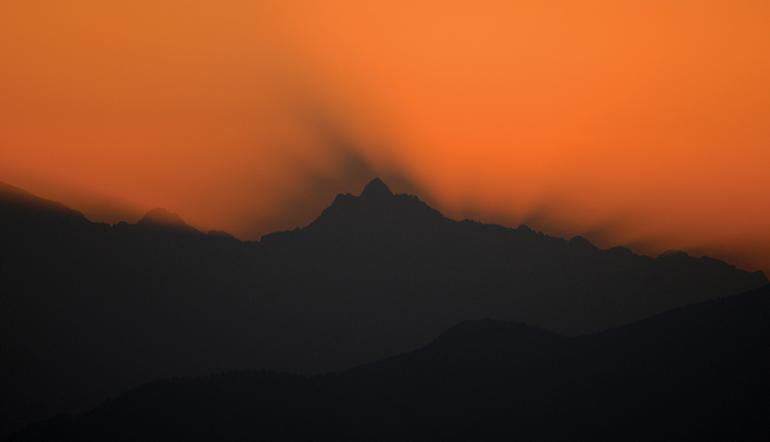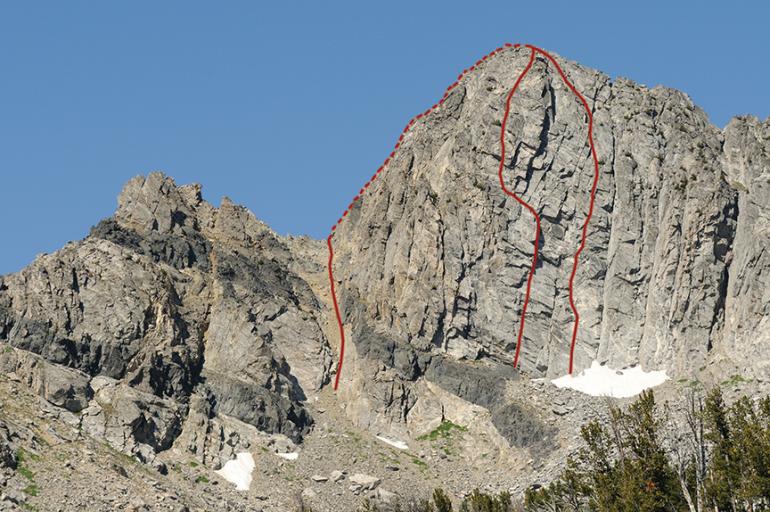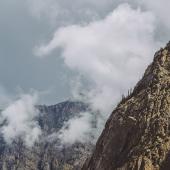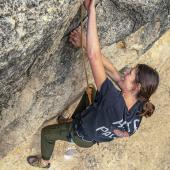Sweet as Honey
Multipitch alpine climbing in Beehive Basin.
Exit the tram atop Lone Peak, let the view wrap your mind with 360-degree exposure—the wild Montana landscape, its dramatic rise and fall of range and valley—and 99% of the time, find your eye drawn to the prominent south face of nearby Beehive Peak, centered along the lofty and jagged northern skyline.
“The Beehive” draws its name from a distinctive appearance, as seen from the Madison Valley, just west of the peak—its conical lines culminating at a fine-tipped point in the sky, a magnetic bull’s-eye to the climber and peak-bagger alike. While not the highest in the vicinity, Beehive remains enticing with excellent rock, shockingly easy access, and a splendid variety of year-round routes, suitable to nearly all levels of experience or technical prowess.
I clearly remember my first view of that outcrop, rising dramatically from deep spring snow, high above the surrounding forest—its features, distinct and striking, with premium climbing lines obvious from miles away. I was smitten.
And I’ve returned, time and again, always impressed with the bang for my buck—very few places offer such instant alpine gratification. Typically, one must travel far and commit days to a project—but that ain’t the case here. While the scale isn’t as grand as our neighboring Beartooth or Teton ranges, the quickness with which you can find yourself in the alpine zone is astonishing. The routes are short, but the weather and conditions are often no different than high on greater faces, making the Beehive a perfect place to hone skills or simply enjoy some great climbing.
While most will enjoy the sunny afternoons of dry, bomber Beehive rock, the final feather in its cap is the variety-pack of adventure possibilities year-round. Whether accessing the classic Middle/Bear Basin powder shots, climbing on wild double-corniced ridges, or bagging one of the classic and ephemeral mixed-rock-and-ice climbs on the south face, the only limit to this alpine playground is one’s imagination.
History
That striking corner system, the one you see from miles away, is now considered the Standard Route, and was first climbed by Jack Tackle and Craig Zaspel in the late ‘70s. After spending time on the Juneau Ice Cap with the insatiable Fred Beckey, Jack was inspired to find first ascents close to home—and he did, in classic Beckey style, choosing the plum line on a prominent and untouched wall. As Jack puts it, “it’s simply the most obvious line on the face.”
This duo continued to tick off three more obvious lines, following one parallel crack system after the other. Holding true to the old Dirty Sox Club climbing ethos, these wilderness climbs were kept quiet and nearly lost to the pages of time and the overwrite of many subsequent “first ascents.”
Tackle later returned on a solo mission. His goal: to repeat his and Zaspel’s center line (now commonly referred to as the Javaman Route), to “figure out how rope soloing worked” and free the few points of aid used to pass steep wet rock on the first ascent. High on the face, a hold broke and Tackle took flight, fully testing his self-belay system and breaking his piton hammer in the (30-foot-airborne) process. Without the hammer, his rack was reduced to a set of stoppers and a few hexes; finishing the route sans pins, Jack gave “clean climbing” a little unintended nudge forward.
Pat Callis and Tom Jungst left a mark as well, with their seldom-repeated 5.11 finger crack on the steep streaks left of center. I double-dog-dare someone to catch the first ascent of the mixed version of this route. Season after season, I either lack the testosterone or botch the timing, but I’ll let you in on a little secret—every spring the off-width crack above the steep fingers section spills a magnificent icicle, dangling in space for a time just after the perfect storm and just before crashing to the ground.
Beta
Continue past Big Sky Resort and turn right on Beehive Basin Rd., just before the entrance to Moonlight Basin. Winding through the forested hillside, you’ll catch excellent views of the peak before dropping steeply to the trailhead at the bottom of the drainage. Please be especially mindful of staying on the marked trails, as this access crosses private land.
Rack
For routes on the south face, I like to bring stoppers #4-11 (doubling 5-9), C3s #0-2, Camalots #.5-3 (doubling .75-2). Add or subtract according to your comfort level.
If you’re considering the mixed lines, add a small selection of short screws and maybe a few pins (KB #2 & 4, plus a #1 baby angle seem to be effective).
Routes
Regular Summit Route – 3rd-Class
Follow the “Fourth of July” or southwest couloir to its top, pass over the notch and descend slightly; enter the west-facing gully above, exiting to the right over a few scrambling moves, et voila—zee summeet!
Reverse to descend.
Heads up—in the early summer season, the initial couloir may be filled with snow and thus make a formidable mountaineering objective. Depending on conditions and comfort level, solid mountain boots and an ice axe are recommended. Keep this in mind if descending in approach shoes. In most years, this couloir is dry by mid-season; watch out for rockfall.
South Face Standard Route – 5.9
If the Beehive has a “Magic Line,” this is it. Situated on the right side of the south face is a large and unmistakable left-facing corner that runs the height of the wall. With many variations and ever-changing snowpack depth at the base, the first pitch is dubious to nail a description on—the recommended line begins just a few feet left of the actual corner and wanders over a 5.7 face, arcing to the right and returning to the corner for the belay. (Beware—there’s a large flake with fixed slings just below this point; the flake is very suspect and should not be trusted.) Pitch two is the crux with 5.9 moves off the belay, traversing black rock to reach the right side of the corner. Once established on the right, enjoy fantastic 5.8 cracks with bomber gear until your rope runs out. Pitch three mellows from easy 5th- to 4th-class before joining the East Ridge route to the summit.
Descend the Regular Route.
“The Javaman” Center Route – 5.10a
Javaman is another premium line that offers sustained climbing on excellent stone. Start in the third corner left of the Standard Route, directly below the massive right-facing system in the center of the face. A bouldery start leads to fingers to fists to, eerrr, well, slightly wider, but only for a few moves before reaching a nice foot ledge at the belay. Moving over slabs above, enter the steep corner and enjoy juggy holds to the next ledge and belay on the left. (This section is difficult to protect and does have ledge-fall potential on the slab below. Alternatively, climb the steep handcrack on the left wall… did I mention that it’s steep?) Pitch three offers several variations. The easiest and quickest way out is to cut left, then follow easy ground to the top. The proud line follows the inside corner for two more pitches of sustained climbing.
Descend as for the Regular Route.
Pete Tapley is a professional climber and guide, and is the lead instructor for the Montana Mountaineering Association.












